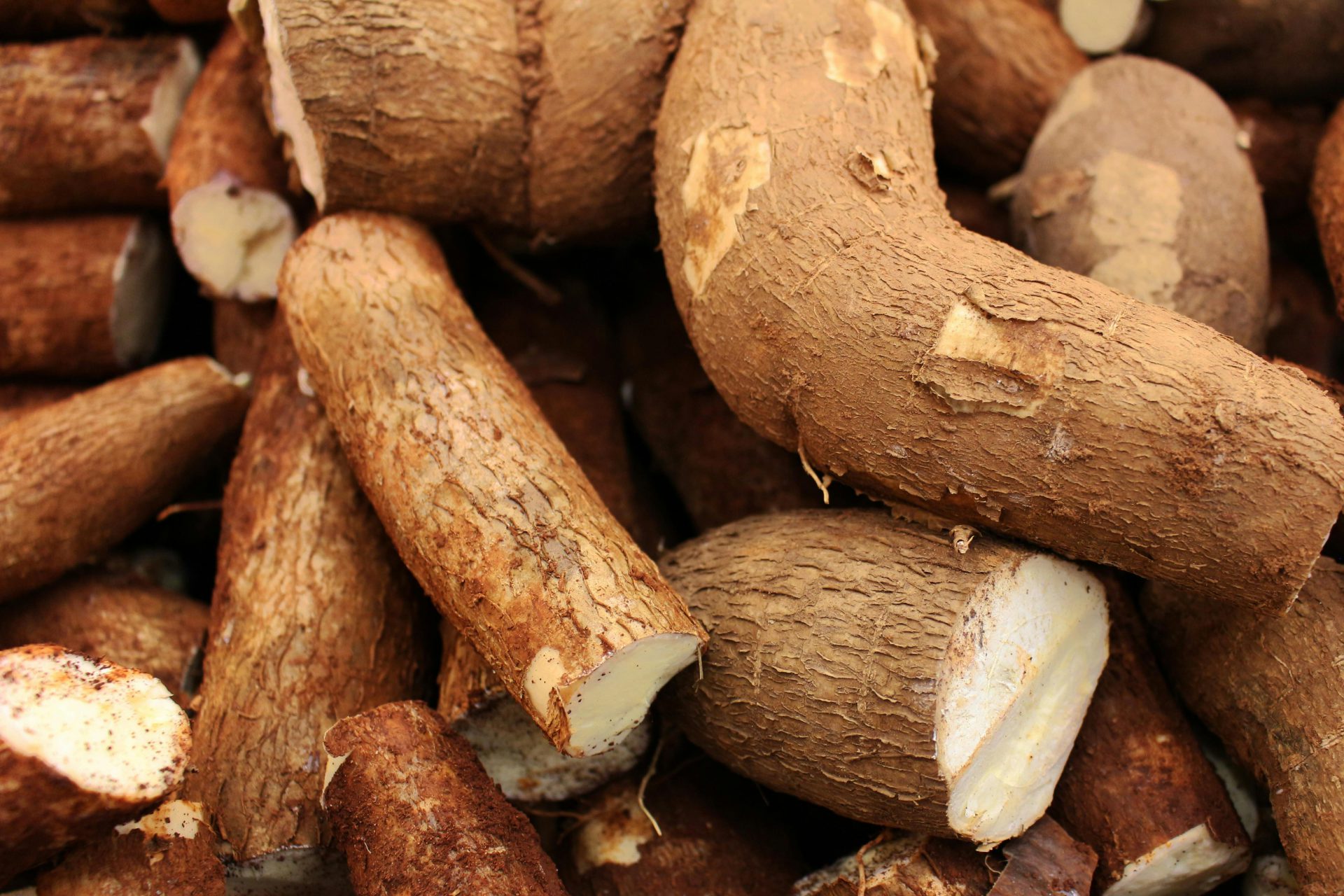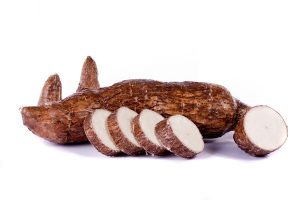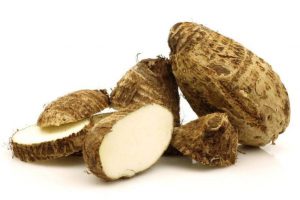
- Readers Rating
- No Rating Yet!
- Your Rating
Cassava
Origin and Cultivation:
Cassava, also known as manioc or yuca, is native to South America and is a staple food in many parts of the world, particularly in Africa, Asia, and Latin America. It is an extremely hardy plant and can grow in poor soils, making it an essential food source in regions where other crops do not thrive.
Nutritional Properties:
Cassava is known for its high carbohydrate content, particularly in the form of starch. Providing approximately 160 calories per 100 grams, it is an excellent source of energy. Although it is relatively low in protein (about 1.4 grams per 100 grams), it contains small amounts of vitamins and minerals, including vitamin C, vitamin A, and some B vitamins such as folic acid.
However, it is important to note that cassava must be thoroughly cooked before consumption, as it contains cyanogenic glycosides, compounds that can be toxic if ingested raw. Cooking destroys these compounds, making cassava a safe and nutritious food.
Culinary Uses:
In cooking, cassava is extremely versatile. It can be boiled, fried, baked, or mashed. In many cultures, it is transformed into flour (tapioca), which is used to make bread, cakes, and other gluten-free products. It is also the base for traditional foods such as cassava bread and cassava arepas.

Yam
Origin and Cultivation:
Yam is a tuber widely cultivated in Africa, the Caribbean, Asia, and Oceania. There are various types of yam, some of which are particularly valued in specific regions, such as water yam, purple yam, and yellow yam. Yam has been a staple food in these areas for centuries, providing a vital source of nutrition.
Nutritional Properties:
Yam is also an excellent source of carbohydrates, but it contains more fiber than cassava, which contributes to a slower and more stable digestion of sugars in the body. Additionally, yam is rich in vitamin C, vitamin B6, and potassium, and contains antioxidants like carotenoids and vitamin E. Some varieties of yam, such as purple yam, are also high in anthocyanins, which are compounds with potent antioxidant properties.
In terms of calories, yam is similar to cassava but has a slightly higher protein content, with about 2 grams per 100 grams. Although this protein is not complete, it contributes to overall nutrition when consumed as part of a balanced diet.
Culinary Uses:
Yam is highly valued in cooking for its texture and flavor. Like cassava, it can be boiled, fried, roasted, or mashed. In West Africa, for example, yam fufu is a traditional dish where yam is boiled and then pounded into a smooth dough. Yam is also used in soups, stews, and can be combined with other ingredients to make cakes and other baked dishes.

Main Differences Between Cassava and Yam
Although both cassava and yam are carbohydrate-rich tubers used in many cultures for similar purposes, there are key differences between these two foods:
Nutritional Composition:
- Cassava: Higher in carbohydrates and calories, but with less fiber and protein. Cassava is an excellent source of quick energy due to its high starch content.
- Yam: Contains more fiber and slightly more protein, making it a somewhat more balanced option nutritionally. It also has more antioxidants than cassava, especially in varieties like purple yam.
Flavor and Texture:
- Cassava: Has a firmer and drier texture when cooked, with a mild flavor that absorbs other tastes well. Its starch makes it ideal for frying and dishes that require a crispy consistency.
- Yam: Softer and creamier, with a slightly sweet flavor depending on the variety. It is ideal for mashes and dishes that require a smoother texture.
Preparation and Use:
- Cassava: Must be properly cooked to remove toxic compounds. It is most commonly used in frying, soups, and as flour (tapioca).
- Yam: More versatile in terms of preparation, does not require a toxin removal process, and is used in a wide range of recipes from stews to desserts.
Availability and Varieties:
- Cassava: Widely available in tropical and subtropical regions, and comes in sweet and bitter varieties.
- Yam: Has many more regional varieties, each with distinctive characteristics, and is more commonly available in Africa and Asia, although it is also grown in Latin America and the Caribbean.
Recipe: Cassava and Yam Purée with Roasted Garlic
This recipe combines the creamy texture of yam with the firmness of cassava, resulting in a purée with a deep, comforting flavor, perfect as a side dish for meat or as part of a vegetarian meal.
Ingredients:
- 500 g of peeled and chopped cassava
- 500 g of peeled and chopped yam
- 4 cloves of garlic
- 50 ml of olive oil
- 100 ml of coconut milk (optional)
- Salt and pepper to taste
- Fresh chopped parsley for garnish
Instructions:
- Prepare the Ingredients: Preheat the oven to 180°C (350°F). Peel the cassava and yam, and cut them into medium pieces. Place the garlic cloves (with skins on) on a baking tray, drizzle with a little olive oil, and roast for 20-25 minutes, or until golden and soft.
- Cook the Cassava and Yam: While the garlic is roasting, place the cassava and yam in a large pot with salted water. Bring to a boil and cook for 20-25 minutes, or until both are tender.
- Make the Purée: Drain the cassava and yam, and return them to the pot. Peel the roasted garlic and add it to the pot. Using a potato masher or large fork, mash the cassava, yam, and garlic until smooth. Add the remaining olive oil and coconut milk (if using), and mix well. Season with salt and pepper to taste.
- Serve: Transfer the purée to a serving dish and garnish with chopped fresh parsley. Serve hot.
Now that you know the differences between cassava and yam, which are often used similarly in cooking but offer different nutritional benefits and flavor profiles that can complement a variety of dishes. Whether you prefer the crispy texture of fried cassava or the creamy smoothness of yam purée, both tubers are nutritious and versatile additions to any diet. Additionally, by incorporating them into recipes like cassava and yam purée with roasted garlic, you can enjoy the best of both worlds in a single dish. Visit the mentta blog to learn more about gastronomy and superfoods.
